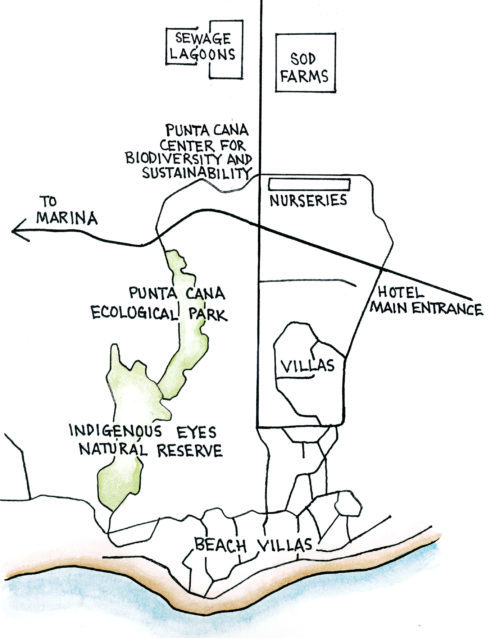Ecological Foundation Trail, Punta Cana
Punta Cana, probably the most well-known resort area in the country, is at the easternmost tip of the Dominican Republic. The habitat of this area is comprised mostly of lowland moist forests, coastal shrub-land, pastureland and urban areas, as well as mangroves, lagoons, and beaches. Punta Cana is the most highly visited Caribbean destination resort. Nevertheless, over 100 different species of birds have been identified in Punta Cana during the winter migration season, and opportunities to learn and appreciate many of Hispaniola’s interesting bird species are available in the Punta Cana area. Our target species for Punta Cana include many species endemic to the island or to the Caribbean region, such as Hispaniolan Parrot, Hispaniolan Lizard-Cuckoo
Antillean Nighthawk, Antillean Palm-Swift, Broad-billed Tody, Palmchat, Bananaquit, Black-crowned Palm-Tanager, and Hispaniolan Oriole, as well as several hard-to-find introduced species such as Eurasian Collared Dove and Pearly-eyed Thrasher. In addition, you may be able to see reintroduced individuals of the islands most endangered bird, the Ridgway’s Hawk.
Since its 1969 inception Puntacana Resort and Club has been recognized as a pioneer of sustainable development and tourism practices. In 1994 the developers founded The Puntacana Ecological Foundation to protect and maintain the health of the coastal ecosystem. The Ecological Foundation was formed with the donation of more than 600 hec of land to be set aside for scientific investigation and conservation. The Foundation also developed the Center for Sustainability and Biodiversity of Puntacana with the help of international collaborators.
Birding Areas
There are a variety of good birding areas at Puntacana Resort and Club that are centered on the Puntacana Ecological Foundation. Behind the Center for Sustainability are a system of short trails that wind through a variety of gardens, tropical fruit orchards, and scrub forest. A longer, more developed trail is known as the Indian Eyes Trail. Access to this circular trail is made through the hotel which is across the street from the Ecological Foundation; you should call ahead to the Foundation if you would like to access this trail but are not a guest of the hotel. The Foundation may also be able to provide a guide.
Closer to the hotel also is the marina which is worth checking for seabirds, but also for Yellow-crowned Night-herons at night. Two additional sites that are well worth a look lie at the end of an access road behind the Ecological Foundation. Within walking distance are a sod farm (on the right) and a series of sewage lagoons (on the left). The sod farm has turned up a number of rarities, including Purple Sandpiper and American Golden-Plover, as well as other shorebirds. The lagoons attract a wide variety of waterfowl, shorebirds, and waders, including both Yellow-crowned and Black-crowned night-herons.
Target Species
Magnificent Frigatebird, Great Blue Heron, Snowy Egret, Tricolored Heron, Reddish Egret, Black- crowned Night- heron, Yellow- crowned Night- heron, Reddish Egret, Ridgway’s Hawk, Wilson’s Plover, Black- necked Stilt, Ruddy Turnstone, Laughing Gull, Royal Tern, Eurasian Collared Dove, Hispaniolan Parrot, Hispaniolan Lizard- Cuckoo, Antillean Nighthawk, Antillean Palm- Swift, Antillean Mango, Vervain Hummingbird, Broad- billed Tody, Hispaniolan Woodpecker, Pearly- eyed Thrasher, Palmchat, Bananaquit, Black- crowned Palm- Tanager, Hispaniolan Oriole
Most visitors to the area will arrive at the Punta Cana International Airport. Visitors driving from Santo Domingo will head east on the main coastal highway to San Pedro de Macorís, then continue on to La Romana passing over the Río Cumayasa bridge (Site D24). About 10.9 km (6.8 miles) east of the Río Cumayasa bridge turn right at a stop light following signs for Casa de Campo and Higuey. Cross the Río Chavón, pass straight through a rotary, until arriving in 19.3 km (12 miles) at a prominent fork in the road (the “La Romana-Bayahibe fork”). Continue on towards Higuey; 15.4 km (9.6 miles) later you will turn north (left) on Route 4 (turning right will take you to Boca de Yuma, Site D28). From here you will travel through sugar cane and grazing pastures for 14.8 km (9.2 miles) where you will arrive at a stoplight.
Turn left at this light following signs for Bávaro, Punta Cana, and the Basilica of the Virgin of Altagracia. At another traffic light a short 1.0 km (0.6 mile) further on, you will rejoin Route 3 (with Route 4 turning left and continuing on towards El Seibo), and you will pass the oppressive Basilica. At the second light beyond the Basilica, follow signs towards Bávaro and Punta Cana and turn right. You will soon leave Higuey headed for Otra Banda which is reached in about 8.0 km (5.0 miles). At the light in Otra Banda turn right, and continue on 24.1 km (15 miles) to the town of Veron. Veron appears as more of a commercial strip, but food, gas and other services are found here which are not readily available in Punta Cana.
From Veron, you will drive east another 3.2 km (2 miles) before encountering a metal arch across the road with a Shell station on the right. Turning left here would take you towards Bávaro on Route 105; you will instead want to continue straight on Route 106 towards Punta Cana. After 5.0 km (3.1 miles) you will need to turn right on a divided highway; this is not signed but there is no other option. Continue straight through two rotaries; at the third rotary bear right to the Puntacana Resort and Club. In about 2.4 km (1.5 miles) you will go straight through yet another rotary, and in 3.5 km (2.2 miles) you should see the entrance for the Fundación Ecológico (Puntacana Ecological Foundation).

- Reserve hours: open daily from sunup to sundown
- Entrance fee: none; open to members and guests, or by special arrangement
- Telephone: telephone 809-959-9221
- E-mail: [email protected]
- Website: www.puntacana.org
